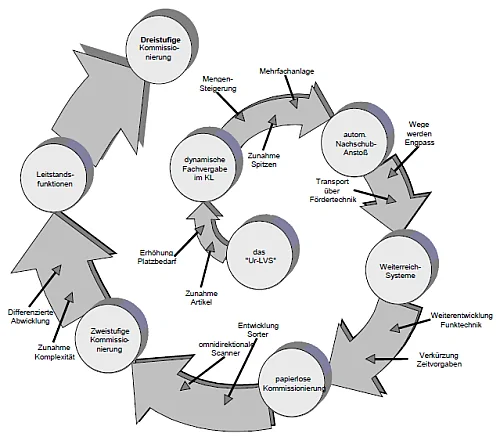Warehouse management has come a long way since its early days. In the past, manual processes were laboriously structured using analog media. Today, both the technology and the process view have undergone fundamental changes.
The figure shows an exemplary overview of the development stages from a simple electronic card index to the highly integrated operational control of a modern warehouse management system. The list of external requirements, technical possibilities and the resulting solutions should not be interpreted as a strictly sequential progression. In individual systems, the development stages described were also passed through in a different order.

However, the development described is in any case associated with an increasing mechanization of the process, which is directly dependent on the reliability of all hardware and software components involved. Therefore, it is mandatory to safeguard the critical components by means of redundant design.
The following rules apply to warehouse management
- All commercially relevant data and all warehouse stock must be reliably secured against data loss.
- Transaction data can be kept volatile if
- Procedures for restarting after data loss exist (e.g. “lap of honor” on the materials handling technology or physical clearing and re-entry).
- the non-dynamic data can be recovered by synchronizing with the higher-level system.
If individual technical components cannot be protected against failure due to an unavoidable “single point of failure” (= failure of this component results in failure of the entire system), a manual emergency procedure should be provided for operation at greatly reduced performance.
Important: Increasing technical reliability by means of redundancy in the components involved is only useful to a certain degree, since each additional redundancy leads to an increase in complexity. However, limiting the complexity of a facility has been proven to be a reliable means of increasing availability (known under the positively interpreted term “Russentechnik”).
By utilizing all the possibilities available today, modern warehouse management allows an increase in productivity (= daily output per employee) of more than a factor of ten compared to purely manual distribution!
The development of a highly integrated logistics system, as indicated in the figure, reaches a certain level of complexity at which point the processes to be controlled can only be managed by installing a control center. A clear overview of the current system status enables the human operator to react to bottlenecks or errors in a timely manner.
Particular attention is paid to:
- the work in progress in the individual areas.
- the progress of the work, i.e. the volumes that have already been processed.
Since, with well-designed technology, the performance of the employees determines the throughput, this information can be used to ensure that the performance in the individual areas is adapted to the current requirements by means of appropriate personnel control (who works when and where?).
Finally, the operator of a complex warehouse needs a range of different statistics to enable him to assess the performance of people and machines.
For information on planning, controlling, providing and optimizing processes along the value chain, see logistics.
Image source: © Cirquedesprit – Fotolia.com
